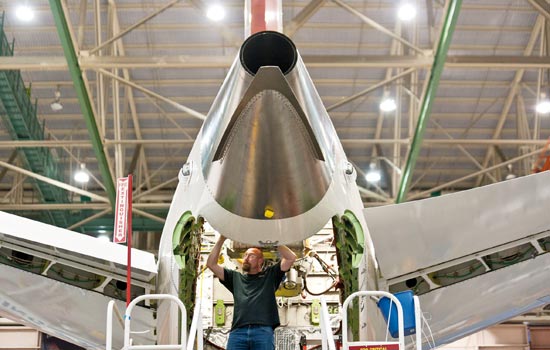 |
|
|
|
|||||||||||
Sino-US cooperation in the aviation industry could be the best way to bring more manufacturing jobs back to the United States and provide the Chinese market with better aviation services.
That's the hope of hundreds of US aviation industry insiders, who are in Shanghai for this week's Asian Business Aviation Conference and Exhibition, or ABACE.
 |
|
An employee works on a Boeing Co 787 Dreamliner at the company’s factory in Everett, Washington.?[Photo/Agencies] |
"At the onset, the demand in China favored larger jets and rotorcraft, but our manufacturers report that they are starting to see demand pick up for medium and small jets, as well as many training airplanes," Caroline Daniels, chairman of the General Aviation Manufacturers Association, said in Washington.
She will participate in the Shanghai event and subsequently travel to Beijing.
GAMA is an international trade association representing more than 70 of the world's leading manufacturers of general aviation airplanes and rotorcraft, engines, avionics, components and related services.
"In China, the market is growing fast and many of our manufacturers are supporting the demand by placing more and more resources in this region to serve their customer base - from sales offices to service centers to parts depots," said Daniels.
According to GAMA data, US manufacturers generated $4.3 billion in new airplane export revenue in 2011, and exports accounted for more than 50 percent of total US airplane billings.
It also said 13.5 percent of business jets delivered went to the Asia-Pacific region in 2011, which is now the third-strongest market. The proportion was triple the level of just five years earlier.
There are now 203 business jets in China, GAMA said.
According to the US Aircraft Owners and Pilots Association, general aviation generates more than 1 percent of US GDP, accounting for 1.3 million jobs in professional services and manufacturing.
Daniels said she was looking forward to meeting local sales agents and learning more about the current state of the market.
"In particular, I am interested in the development of the infrastructure essential to maintain the airworthiness of the aircraft," Daniels said.
"My current understanding is there is considerable work to be done in China to develop this complex infrastructure, without which safe and reliable aircraft operations cannot occur," she added.
Daniels is not the only US aviation industry insider who is eager to find more Chinese customers or cooperation partners through ABACE, at a time of malaise for the global aviation market.
According to GAMA, in 2011, market distribution increased only in the Asia-Pacific region and North America, while billings fell in Europe, Latin America, the Middle East and Africa.
Though Lycoming Engines has not seen a large increase in trade with China so far, Michael Kraft, senior vice-president and general manager, told China Daily he "definitely sees that China is on a strong path to creating a significant general aviation market".
He added: "As the pilot population increases and small aircraft operations and ownership expand beyond flight schools, we will see our customer base shift to the broader population."
He said Lycoming engines power the majority of the fixed-wing aircraft training fleet in China, and flight schools will remain the company's largest group of potential customers in China for the immediate future.
The event in Shanghai won't be the first time for Kraft to seek cooperation opportunities with China. His company has also been regularly involved in aviation events in China, such as the 2011 China International General Aviation Convention in Xi'an and the 2010 Zhuhai Air Show.
"It took the United States many years to develop its general aviation infrastructure and industry. China has done an excellent job so far of implementing best practices from around the aviation world and this will help establish its aviation footprint much more quickly than the US and European markets developed 60 to 70 years ago," Kraft said.
ABACE, which ends on Thursday, is jointly sponsored by the National Business Aviation Association and the Asian Business Aviation Association.
Aviation International News Managing Director Wilson S. Leach said that many US manufacturers are shifting attention from the European market to China, and their China operations have become bigger to meet rising demand.
"I don't know of a single company in business aviation that did not experience major corrections in late 2008, all of 2009, and to a certain degree, 2010 and 2011," he said.
He noted that business jet deliveries declined from an all-time high in 2008 of 1,313 units to 870 units in 2009, 763 units in 2010 and an estimated trough of 650 units this year.
"Our industry continues to look for business outside the US, and with impressive results. Depending on the manufacturer, as much as two-thirds to three-quarters of current aircraft sales are being made outside of North America, with particularly strong demand coming from China," he said.
China is the biggest buyer of US-made Boeing Co aircraft, with a total of 820 serving Chinese airlines, or 49 percent of the total planes in service.
chenjia@chinadaily.com.cn